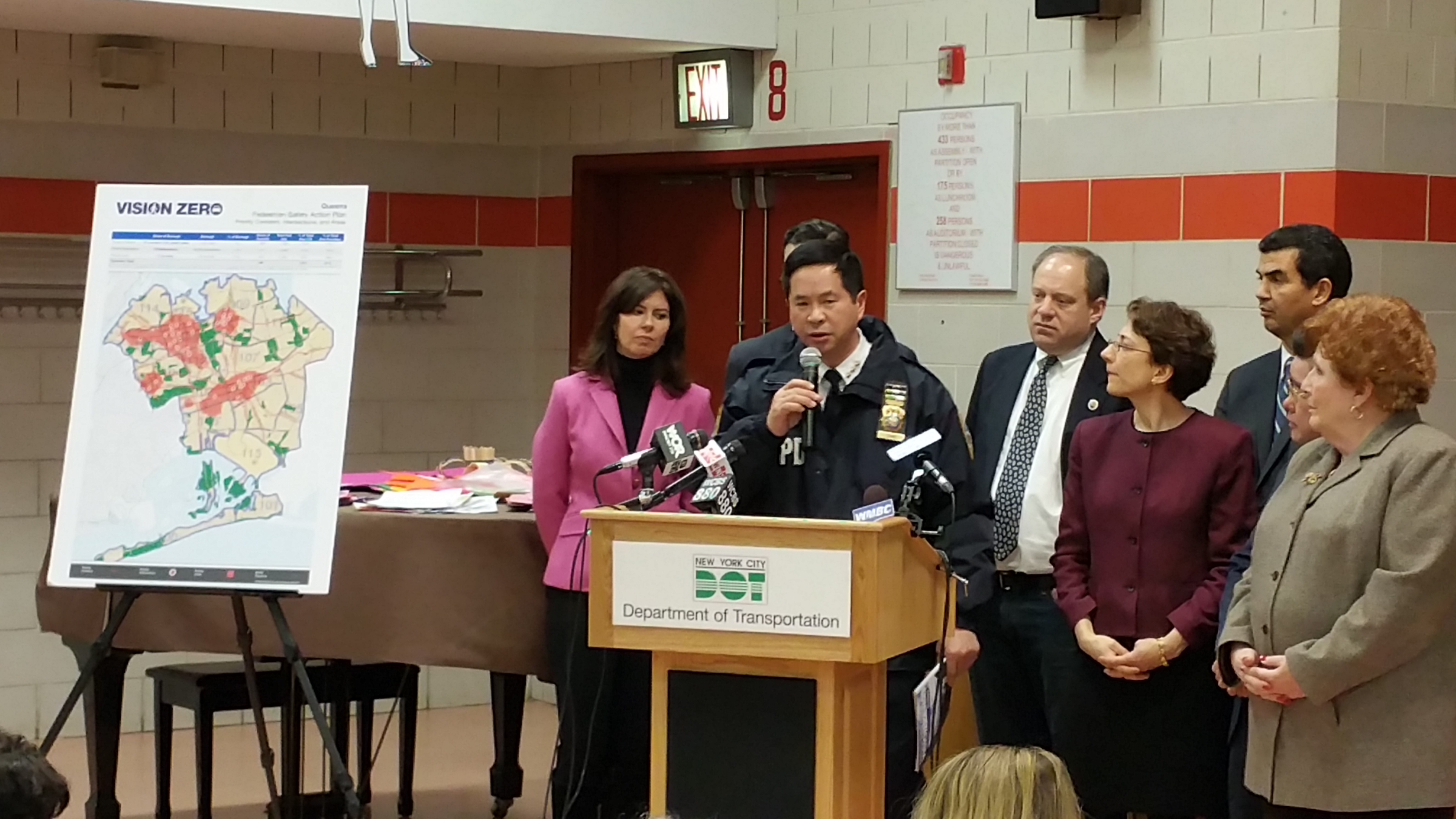
NYPD Transportation Chief Thomas Chen detailed the enforcement aspect of the Pedestrian Safety Plan. Forum Photo by Michael V. Cusenza.
Parts of Mayor Bill de Blasio’s sweeping Vision Zero program have yet to be completed and rolled out, but on Tuesday the administration unveiled the first of five pivotal VZ pieces: the Queens Borough Pedestrian Safety Plan—characterized by the Department of Transportation and NYPD as “a major step” toward achieving zero traffic fatalities on city streets.
The Borough Plans are one of 63 VZ initiatives announced last year, and were developed by integrating detailed crash analysis with input from 28 town halls and public workshops, including over 10,000 comments submitted by residents of Queens, Manhattan, Brooklyn, the Bronx and Staten Island.
The analysis and input resulted in the identification of Queens’ most dangerous corridors, intersections, and areas, which are identified in the plan’s Priority Map.
The announcement was held at Hammond Public School 82 in Jamaica, not far from the intersection of Metropolitan and Hillside avenues, the location of a major redesign project scheduled for implementation later this year. Both Hillside Avenue and Metropolitan Avenue are identified in the plan as “Priority Corridors,” meaning that they have historically had high rates of death and severe injury to pedestrians.
All five of the Action Plans are comprised of three components: Engineering and Planning; Enforcement; and Education and Awareness. According to DOT, Queens’ Priority Map will serve as a guide for the agency, the Police Department and others to systematically address streets which show high rates of fatalities and serious crashes.
Under Engineering and Planning, the actions tailored to Queens include: Implement at least 50 Vision Zero safety engineering improvements annually at Priority Corridors, Intersections, and Areas citywide; expand exclusive pedestrian crossing time on all Queens Priority Corridors by the end of 2017; add exclusive pedestrian crossing time to all feasible Queens Priority Intersections by the end of 2017; modify signal timing to reduce off-peak speeding on all feasible Queens Priority Corridors by the end of 2017; install additional speed-limit signs on all Queens Priority Corridors in 2015; drive community input and engagement at Queens Priority Corridors, Intersections, and Areas; install additional lighting under elevated trains and at other key transit stops; coordinate with the Metropolitan Transportation Authority to ensure bus operations contribute to a safe pedestrian environment; expand the bicycle network in the borough that improves safety for all road users; proactively design for pedestrian safety in high-growth areas in Queens, including locations in the Housing New York plan.
City Councilman Rory Lancman (D-Hillcrest) applauded the work of DOT, saying they have approached the issue “as visionaries, but not as zealots,” building on a data-driven collaborative process that also relies on dialog with communities.
“This is going to make a real difference,” he said of the plan.
NYPD Transportation Chief Thomas Chan said the Enforcement component will: Implement the majority of speed cameras at Priority Corridors, Intersections, and Areas; focus enforcement and deploy dedicated resources to Queens precincts which overlap substantially with Priority Areas; and concentrate targeted enforcement at all Queens Priority Corridors, Intersections, and Areas annually
Education and Awareness campaigns of the Queens Pedestrian Action Plan will: Target child and senior safety education at Queens Priority Corridors and Priority Areas; launch multilingual public information campaigns in Queens Priority Areas; focus Street Team outreach at Queens Priority Corridors, Intersections, and Areas.
In Vision Zero’s first year, pedestrian fatalities fell to 134, the lowest level since 1910, and overall traffic fatalities were down by 15 percent from 2013.
“New Yorkers lives have been saved by the work of DOT and the enforcement of NYPD,” Councilwoman Elizabeth Crowley (D-Glendale) said on Tuesday.
And in order to continue to drive those numbers down, especially in Queens, DOT Commissioner Polly Trottenberg said it will take a unified effort.
“Everyone has a responsibility under Vision Zero,” she noted.
By Michael V. Cusenza

